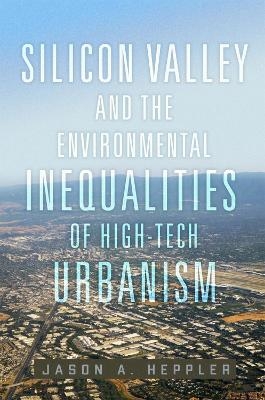
Silicon Valley and the Environmental Inequalities of High-Tech Urbanism Volume 9
Seiten
2024
University of Oklahoma Press (Verlag)
978-0-8061-9373-1 (ISBN)
University of Oklahoma Press (Verlag)
978-0-8061-9373-1 (ISBN)
- Lieferbar
- Versandkostenfrei
- Auch auf Rechnung
- Artikel merken
In the half century after World War II, California’s Santa Clara Valley transformed from a rolling landscape of fields and orchards into a high-tech industrial corridor. How Santa Clara Valley became Silicon Valley and came to embody both the triumphs and the failures of a new vision of the American West is explored in this book.
In the half century after World War II, California’s Santa Clara Valley transformed from a rolling landscape of fields and orchards into the nation’s most consequential high-tech industrial corridor. How Santa Clara Valley became Silicon Valley and came to embody both the triumphs and the failures of a new vision of the American West is the question Jason A. Heppler explores in this book. A revealing look at the significance of nature in social, cultural, and economic conceptions of place, the book is also a case study on the origins of American environmentalism and debates about urban and suburban sustainability.
Between 1950 and 1990, business and community leaders pursued a new vision of the landscape stretching from Palo Alto to San Jose—a vision that melded the bucolic naturalism of orchards, pleasant weather, and green spaces with the metropolitan promise of modern industry, government-funded research, and technology. Heppler describes the success of a new, clean, future-facing economy, coupled with a pleasant, green environment, in drawing people to Silicon Valley. And in this overwhelming success, he also locates the rapidly emerging faults created by competing ideas about forming these idyllic communities—specifically, widespread environmental degradation and increasing social stratification. Cities organized around high-tech industries, suburban growth, and urban expansion were, as Heppler shows, crucibles for empowering elites, worsening human health, and spreading pollution.
What do “nature” and “place” mean, and who gets to define these terms? Key to Heppler’s work is the idea that these questions reflect and determine what, and who, matters in any conversation about the environment. Silicon Valley and the Environmental Inequalities of High-Tech Urbanism vividly traces that idea through the linked histories of Silicon Valley and environmentalism in the West.
In the half century after World War II, California’s Santa Clara Valley transformed from a rolling landscape of fields and orchards into the nation’s most consequential high-tech industrial corridor. How Santa Clara Valley became Silicon Valley and came to embody both the triumphs and the failures of a new vision of the American West is the question Jason A. Heppler explores in this book. A revealing look at the significance of nature in social, cultural, and economic conceptions of place, the book is also a case study on the origins of American environmentalism and debates about urban and suburban sustainability.
Between 1950 and 1990, business and community leaders pursued a new vision of the landscape stretching from Palo Alto to San Jose—a vision that melded the bucolic naturalism of orchards, pleasant weather, and green spaces with the metropolitan promise of modern industry, government-funded research, and technology. Heppler describes the success of a new, clean, future-facing economy, coupled with a pleasant, green environment, in drawing people to Silicon Valley. And in this overwhelming success, he also locates the rapidly emerging faults created by competing ideas about forming these idyllic communities—specifically, widespread environmental degradation and increasing social stratification. Cities organized around high-tech industries, suburban growth, and urban expansion were, as Heppler shows, crucibles for empowering elites, worsening human health, and spreading pollution.
What do “nature” and “place” mean, and who gets to define these terms? Key to Heppler’s work is the idea that these questions reflect and determine what, and who, matters in any conversation about the environment. Silicon Valley and the Environmental Inequalities of High-Tech Urbanism vividly traces that idea through the linked histories of Silicon Valley and environmentalism in the West.
Historian Jason A. Heppler is Senior Software Developer at the Roy Rosenzweig Center for History and New Media at George Mason University and Affiliate Fellow at the Center for Great Plains Studies at the University of Nebraska–Lincoln. He is the creator or collaborator on numerous digital history projects, including the William F. Cody Archive, American Religious Ecologies, and the American Indian Digital History Project.
| Erscheinungsdatum | 21.03.2024 |
|---|---|
| Reihe/Serie | The Environment in Modern North America |
| Zusatzinfo | 9 b&w illus., 5 maps |
| Verlagsort | Oklahoma |
| Sprache | englisch |
| Maße | 152 x 229 mm |
| Gewicht | 272 g |
| Themenwelt | Sachbuch/Ratgeber ► Geschichte / Politik ► Regional- / Landesgeschichte |
| Geisteswissenschaften ► Geschichte ► Allgemeine Geschichte | |
| Geisteswissenschaften ► Geschichte ► Regional- / Ländergeschichte | |
| Technik ► Umwelttechnik / Biotechnologie | |
| ISBN-10 | 0-8061-9373-5 / 0806193735 |
| ISBN-13 | 978-0-8061-9373-1 / 9780806193731 |
| Zustand | Neuware |
| Haben Sie eine Frage zum Produkt? |
Mehr entdecken
aus dem Bereich
aus dem Bereich
von der osmanischen Eroberung bis zur Gründung des Staates Israel
Buch | Softcover (2023)
C.H.Beck (Verlag)
CHF 26,50
von der Staatsgründung bis zur Gegenwart
Buch | Softcover (2023)
C.H.Beck (Verlag)
CHF 16,80


